A road trip through Austria
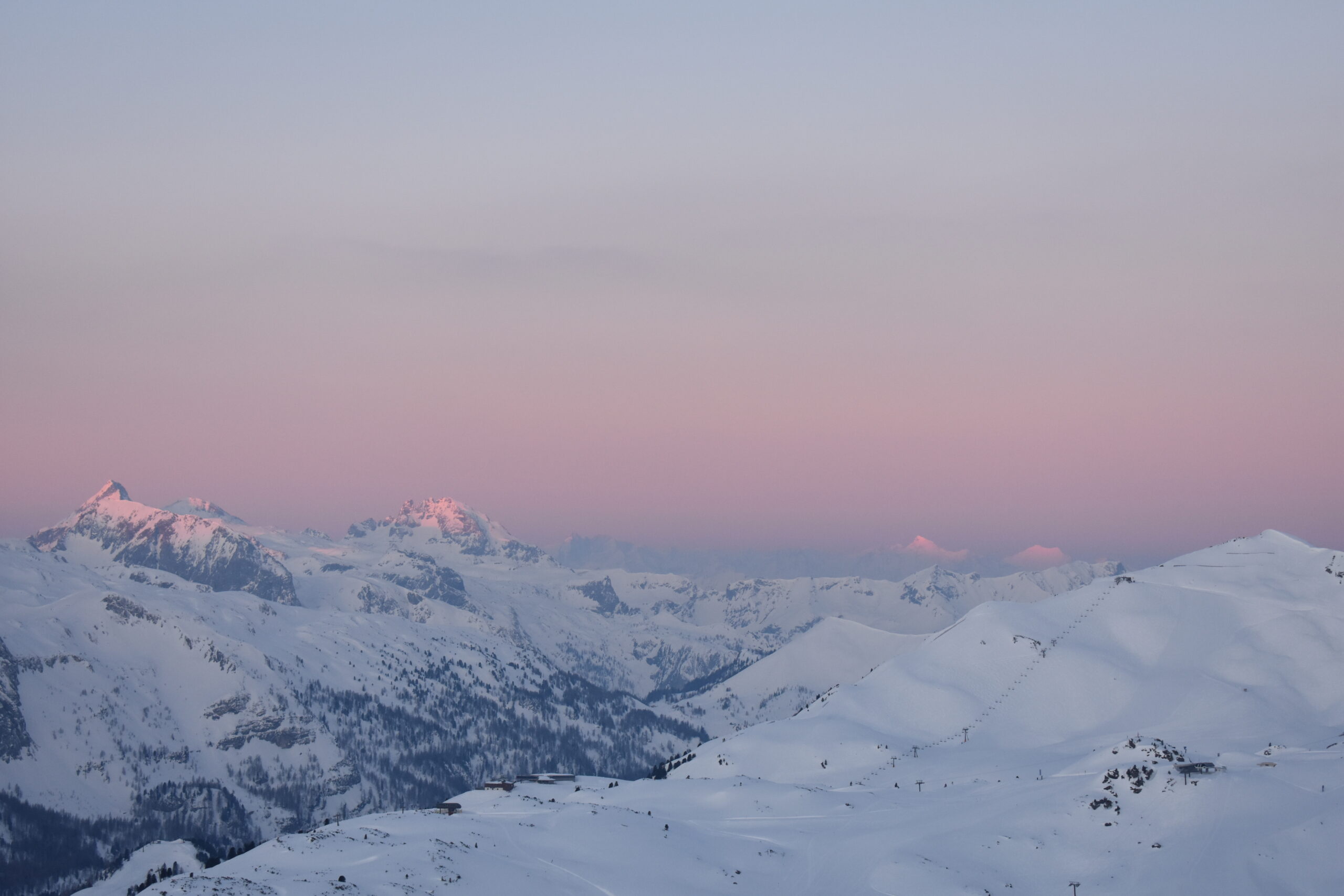

Four buddies. Three long seasons without a group ski trip. Two weeks off. One Audi e-tron and an aim to make this spring road trip a low-carbon ski holiday. We draw a finger across the map of Austria – it’s almost a given that we’ll land on a ski region – to choose where.
SalzburgerLand it is. We boast about the plan, four smug skiers in an electric car, skiing green, and tell everyone to watch this space…
We assemble at Ashford station at 5am from various points in England, pack up and head off, Alps-bound. Time-wise, and green-wise, crossing the Channel by Eurotunnel from Folkestone to Calais (in 35 minutes) is the way to do it: the train crossing contributes 2kg CO2e versus 147kg CO2e by ferry. There are a handful of charging terminals at the Flexiplus passenger lounge. So far so good…
Ploughing through the flats of Ypres, we pull into several big petrol stations for fuel, and check out the fast charger situation: where there are rapid chargers, there are also as many cars hovering in wait. More needed…
Heading into Germany, resisting full throttle on the autobahn (can we save energy in a Merc’s slipstream?!) onwards to Austria, we roll into Altenmarkt im Pongau 12 hours later in time for dinner at family hotel Kesselgrub – powered on hydroelectricity – and crash out.
Now you can’t come to Altenmarkt without visiting the Atomic factory – the facility that produces circa 400,000 skis annually where, during our tour, we saw not one but five racers drop in for a tuning. We head out, brand new skis on shoulders, ready for action.
Altenmarkt is a family friendly kind of ski hill; we’re looking for something bigger to test out the brand new Redsters and Clouds we’ve picked up in the home of Atomic here in Altenmarkt, and we drive a few kilometres up the road to Zauchensee with its pristine pistes (and, I’m assured, great freeriding, though not today after a dry, very cold fortnight…). We kit up, dump the motor for the day, and head above 2,000m.
Zauchensee is part of Ski Amadé, a mega ski area connecting 25 ski resorts across five regions. The tiny Zauchensee village sits at 1,350m above the snowline, with mountains rising either side of the village – prime for losing a team member as you switch from one side to the other. Three stretch their legs on the long, open, winding blues as I take on the beautiful, steep pistes on the western side of the resort.
Legs cooked after an unbeatable day on the hill we’re back down the valley. Altenmarkt might not have the linked pistes and vertical for charging, it does have a mighty toboggan track at the top of which is the Hochnössleralm, wonderful for an evening of local cuisine and traditional music, followed by a merry sled down to town.
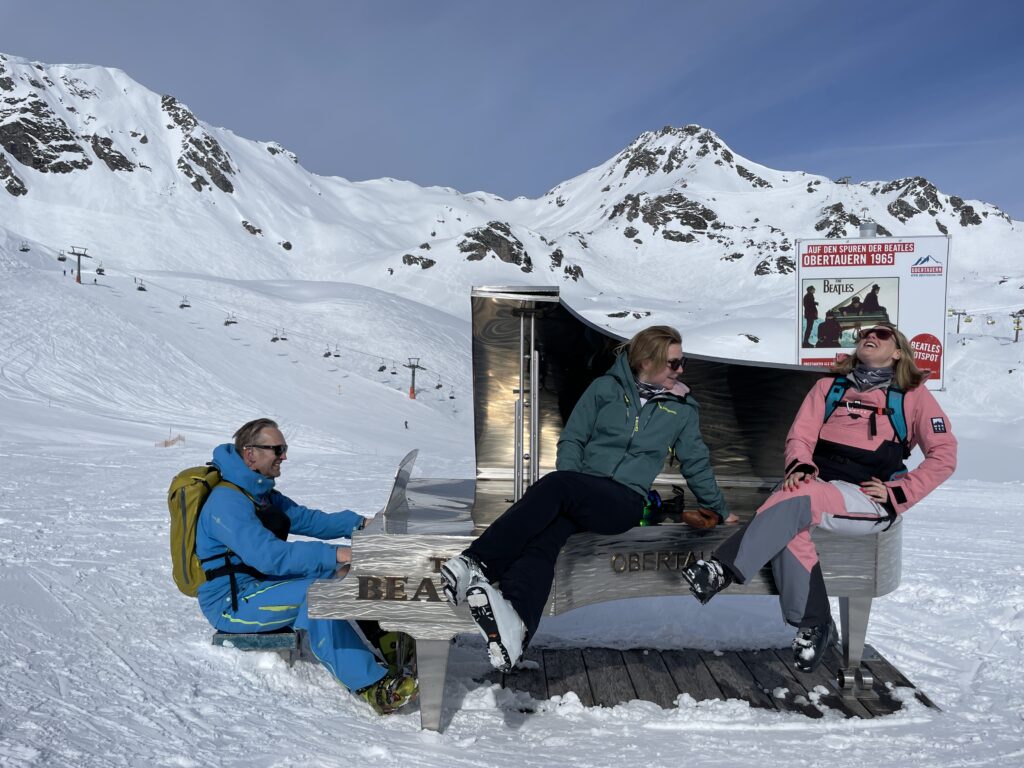
A 20-minute drive from Zauchensee, and a hella scenic one at that.
Obertauern has an interesting set up; A road runs through the middle resort and ski area (tauern means ‘high mountain pass’), separating the beginner hill from the main ski area – a natural cirque of mountains which makes for an easy-to-navigate, all-out-to-see enormous ski area. From its central point, modern lifts fan out in every direction and practically everything is skiable. While there’s no real village centre, it certainly doesn’t affect the après with music blaring from piste-side bars on the lower slopes drawing skiers in at the end of the day.
Best of all is night skiing in Obertauern. Mondays and Tuesdays see floodlights illuminate a 1,500m run at Edelweissbahn, with even some off-piste and a little tree skiing to be had to the side of the run.
So, piste skiing – tick. Night skiing – tick tick. Sunrise skin? Hell yes…
Still dark, two of us came good (from a schnapps-fuelled plan for a dawn patrol) and got out of the door before sunrise to skin up Hundskogel (2,300m) at the north end of Obertauern. We rush to get ready under the stars and set out from the Kingsalm restaurant and lift base (1,600m). It’s been a while since I’ve been up early enough for this but we haven’t left time for the mellower blue ascent option, and set off at a lick up the red slope under Schoenalmbahn, racing the sun. From Schoenalmbahn we skin to Hundskogelbahn, there coming off the piste to follow the ridge round the back of the Hundskogel mountain to its rime-iced summit cross.
Bingo – we make it just as the sun is crowning the east end of the Obertauern valley, about an hour after we set out. The snow-covered valley glows pink and orange and it’s -15C up here with windchill. It’s going to be an interesting descent. We set off, the rattle of our light-weight touring skis is like machine-gun fire on the frozen crust. I feel like we’re waking the entire valley still sleeping below.
An(other) Obertauern highlight, for those that like it steep, is to take the two-man Gamsleiten II towards the end of the day when the sun hits it. The views up top are spectacular, and it’s a long, consistently pitched 45° descent. Later this month at Gamsleiten II, a treasure hunt will be held with prizes buried under the snow that range from a season lift ticket, to skis, to a brand new car. (Makes note to self: come back end of March next season…)
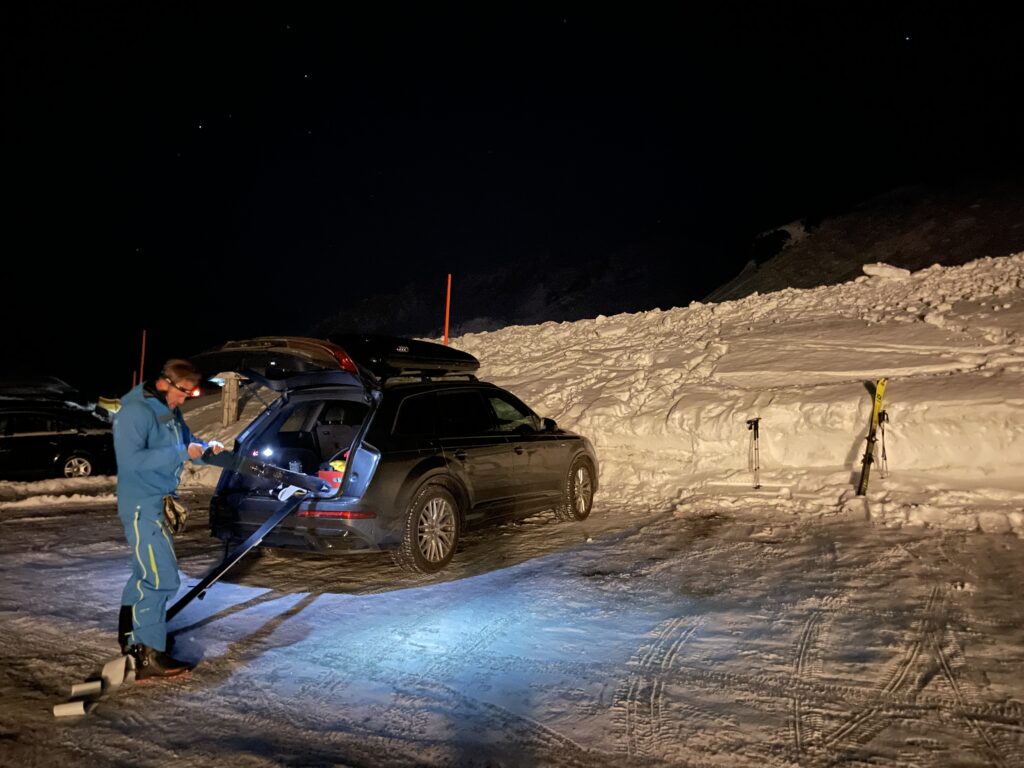
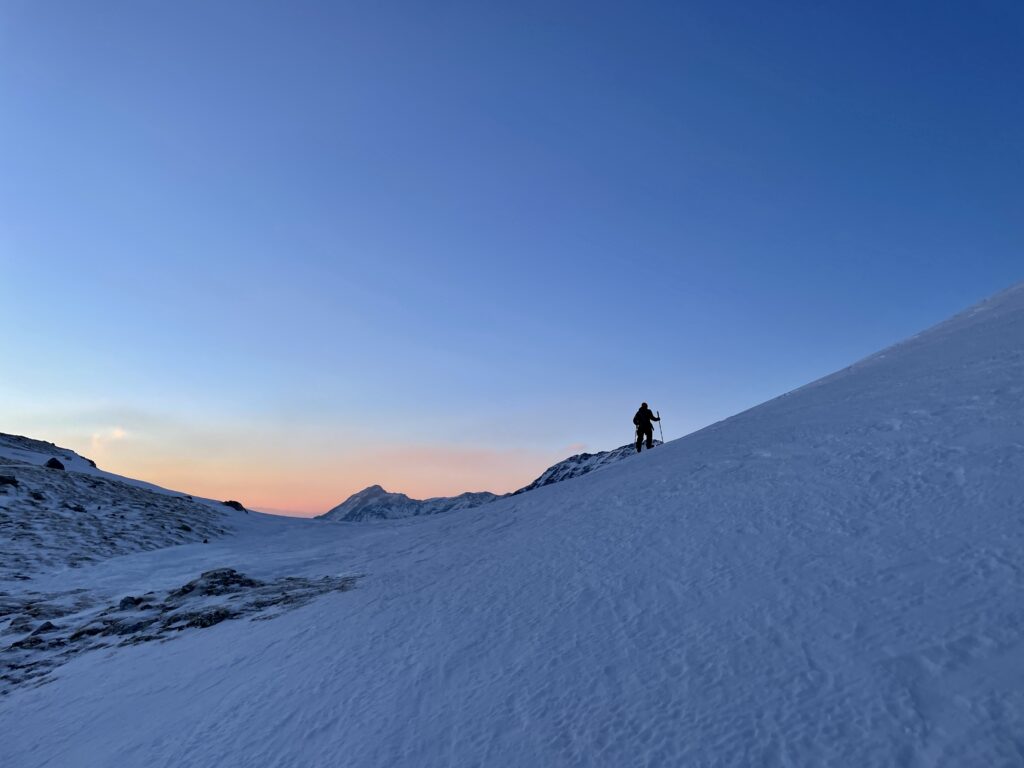
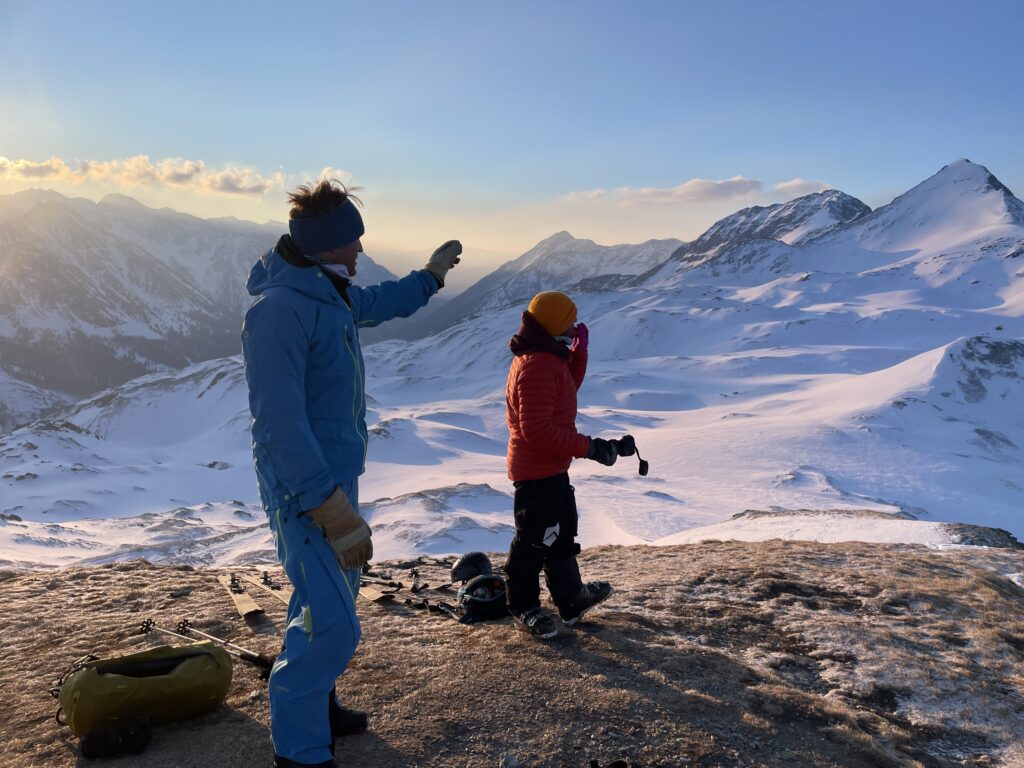
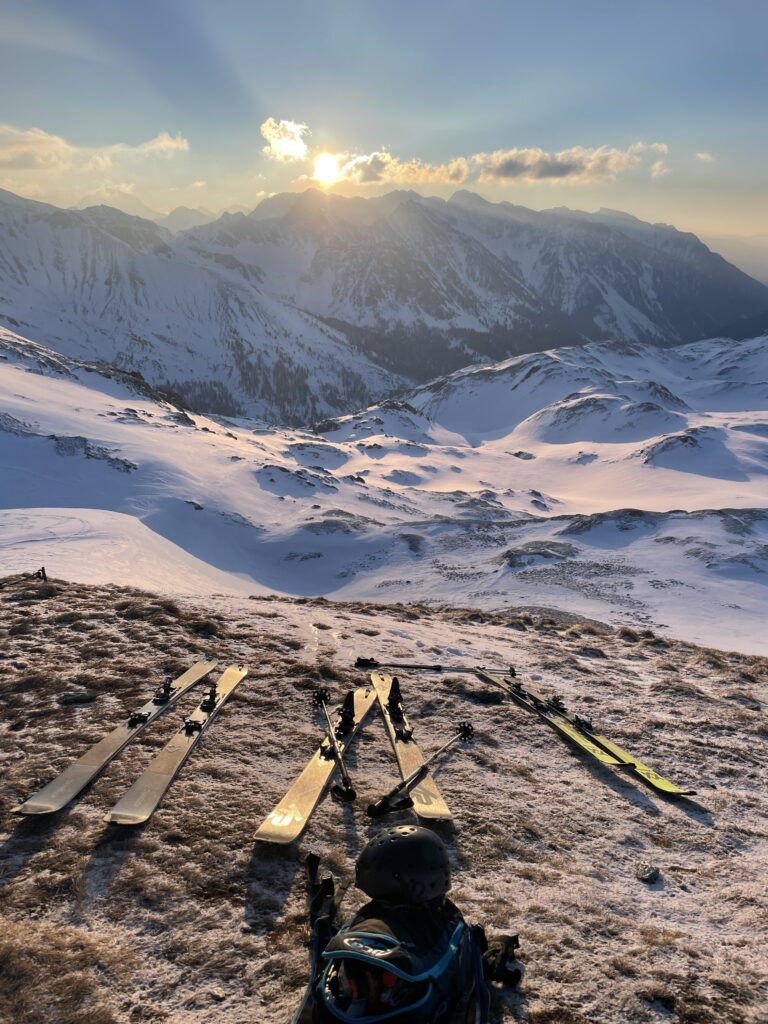
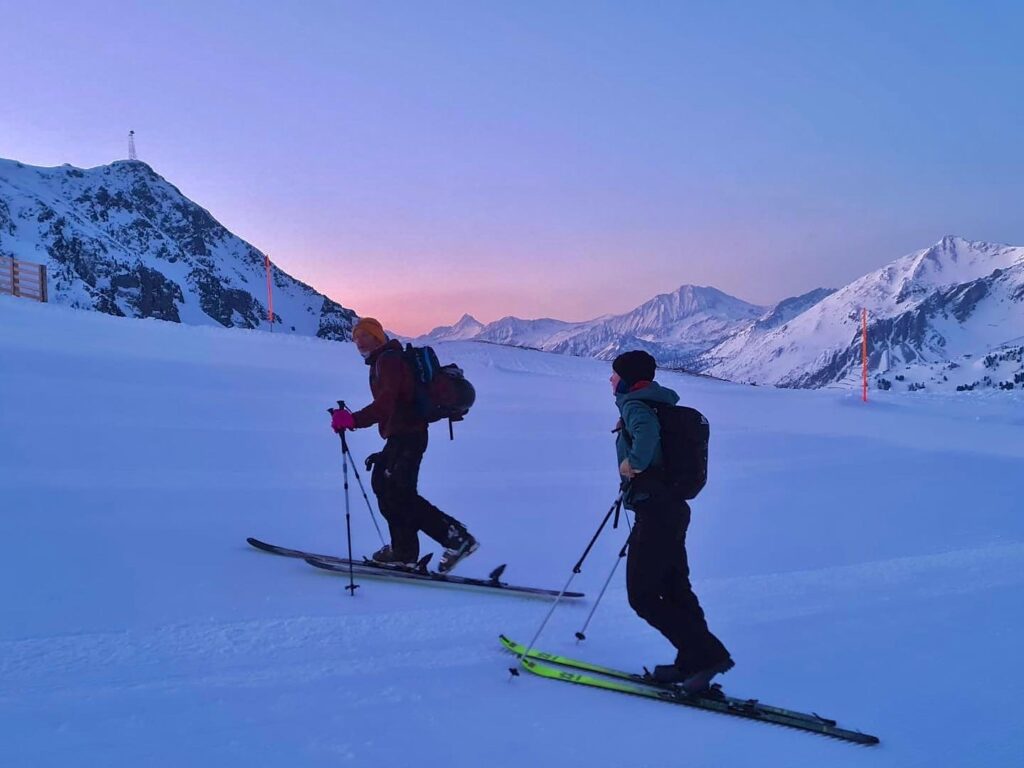
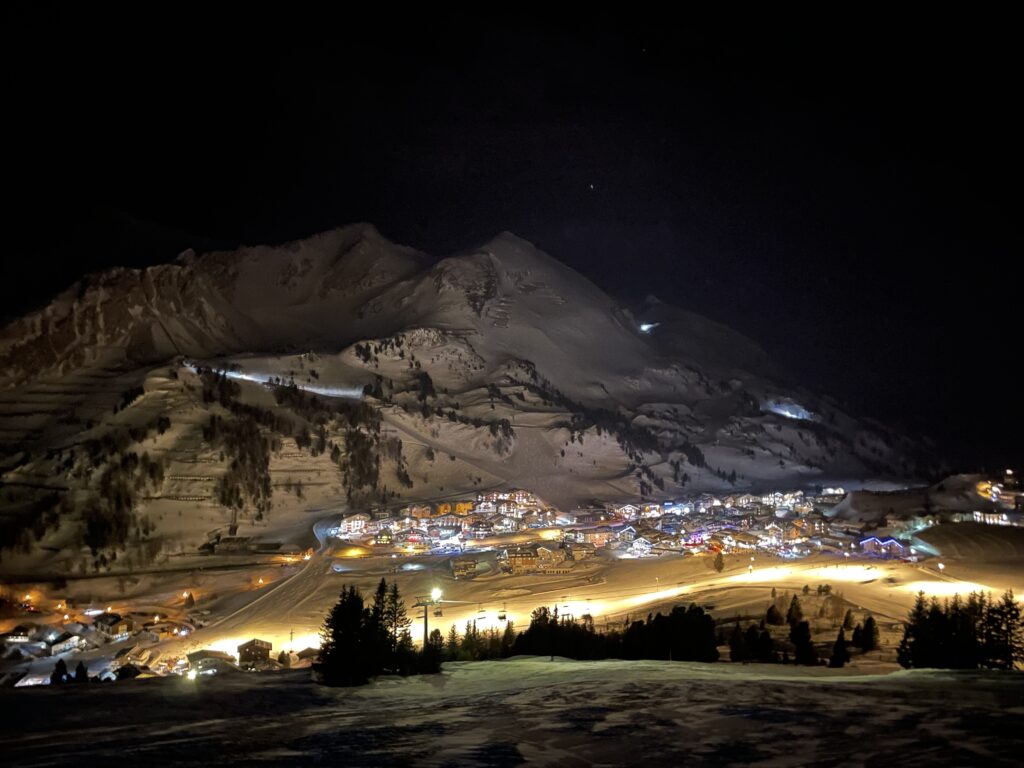
My notes on this journey on from Obertauern simply read: ‘drive to Leogang – f***ing insane’. And we’re on the last leg of the roadtrip.
This is why you drive to the mountains. It’s not for the slog out and back, that’s for sure, but the sweet spots in between. The landscape in this part of Austria is stupidly picturesque.
Austria is, by nature, set up to be green. The country’s traditional way of life in the mountains engenders eco-conscious living. It’s also a powerhouse of green innovation, technology and manufacturing and, it promises, sustainable tourism.
Leogang is a good example of this. Snow runoff is collected in two reservoirs each spring-summer, to be pumped back onto the mountain by snow cannons the next season, which are powered by hydro plants; a satisfying self-sustaining cycle, no?
Excess energy – heat – created by the lift station is syphoned off to warm the mountain’s restaurants and workshops. Biofuels are used for piste bashers, cable cars run at slower, energy saving speeds, and there are more organic farmers in Leogang than anywhere else in Austria. A vending machine at one (of two) base stations sells bread, milk and cheese, stocked by local farmers. Aesthetically, it’s look is au naturel. Buildings are made from stone or are dark wood clad to fit into the natural surroundings – all are low-rise and invisible from afar.
Eco credentials aside, Leogang talks about its lassig – laid back – nature, which I’ll second. Its tiny village centre (bakery, church, pharmacy sums it up) is not exactly jumping. Off the slopes, it’s hard to find its local buzz… But situated on a valley road with Salfelden 7km in one direction (the nearest town centre with shops) and Sankt Johann 25km in the other (via Fieberbrunn) Leogang is not exactly isolated. And ski wise? While the slopes aren’t massively high, the area does appear to be a dumping ground and the snow is in great shape for the season.
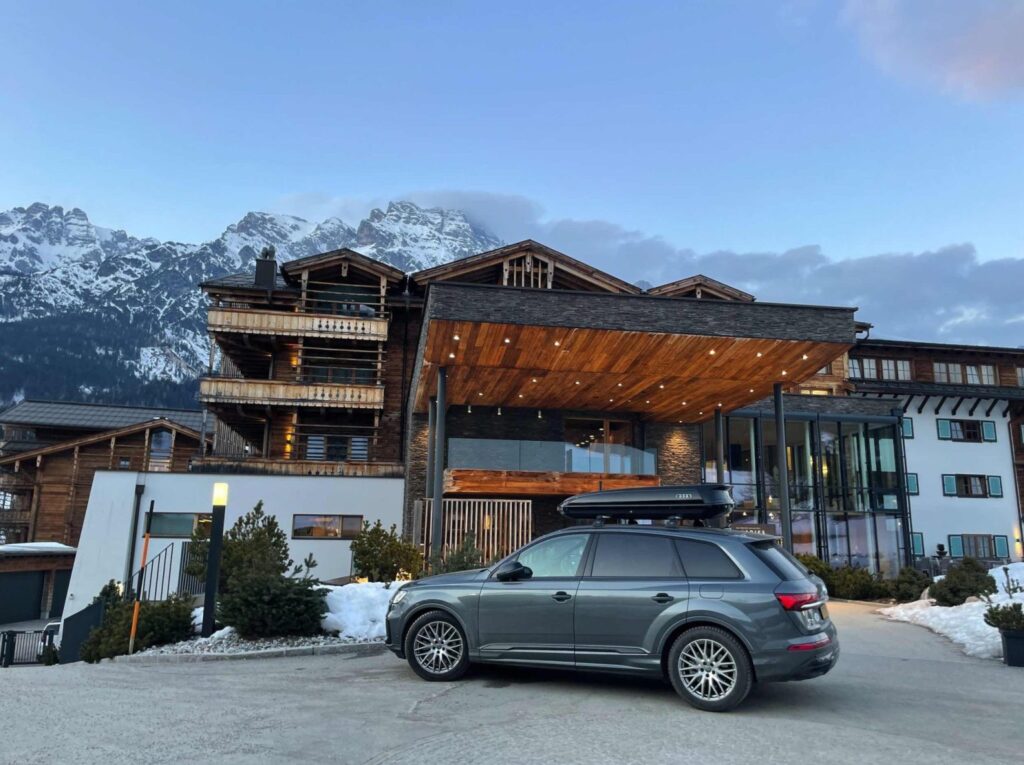
Leogang is part of the Skicircus Saalbach Hinterglemm Leogang Fieberbrunn ski area (- yes, that’s its full name incorporating all its partner resorts). There’s 270km of slopes, and it’s possible to head into the Zell am See ski area too (though making your way back in time at EOP might be a push). The furthest point from Leogang in the Skicircus is Salbaach, perfectly skiable in a day, if you are looking for a town that’s jumping…
So while Leogang is not about the party, it is all about the eco retreat hotel. Half a dozen (maybe more, it’s hard to tell how many are hiding, so well they’re disguised) blend into its north facing hills. Hotel Puradies is one, beautiful, luxurious and comfortable. Inside, its designed to look something like a grand tree house, with a huge wooden bar and sculptural spiral staircase. Family owned, one of the sons wearing a jumper reading ‘there is no planet b’ tells us of upcoming plans to drill down for a ground source heat pump, so the hotel can run exclusively from ground and sun energy. These spa hotels are all about R&R, and eating and drinking very well, but Puradies avoids being flashy. For a more traditional, no-less-luxury eco retreat look up Priesteregg, wonderful for an evening meal surrounded by (we found them!) Austrian locals.
Lassig Leogang’s vibe might be, but there’s flashy to find if you want it. Hendl Fischerei is a small alpine champagne bar, located at the top of Leogang’s Steinbergbahn bubble, that pumps out music, has a mega wine list and is made entirely of wood, with a wrap-around balcony and views of the Pinzgau region to boot. But it’s less your ski-boot-dancing-on table vibe, and more of a sophisticated, sit-down kind of affair. I’m aware of a growing habit of mine, in my 4th decade of skiing, in which I like to pick out low-key resorts only to sniff out its most boujie spot… Case in point at Hendle Fischerei… We have a big drive back tomorrow (10+ hours) so we go and do our best to make it feel as long as possible at the top of Leogang, ’til the lifts shut, when we’re kindly told to shove off and ski home to bed.
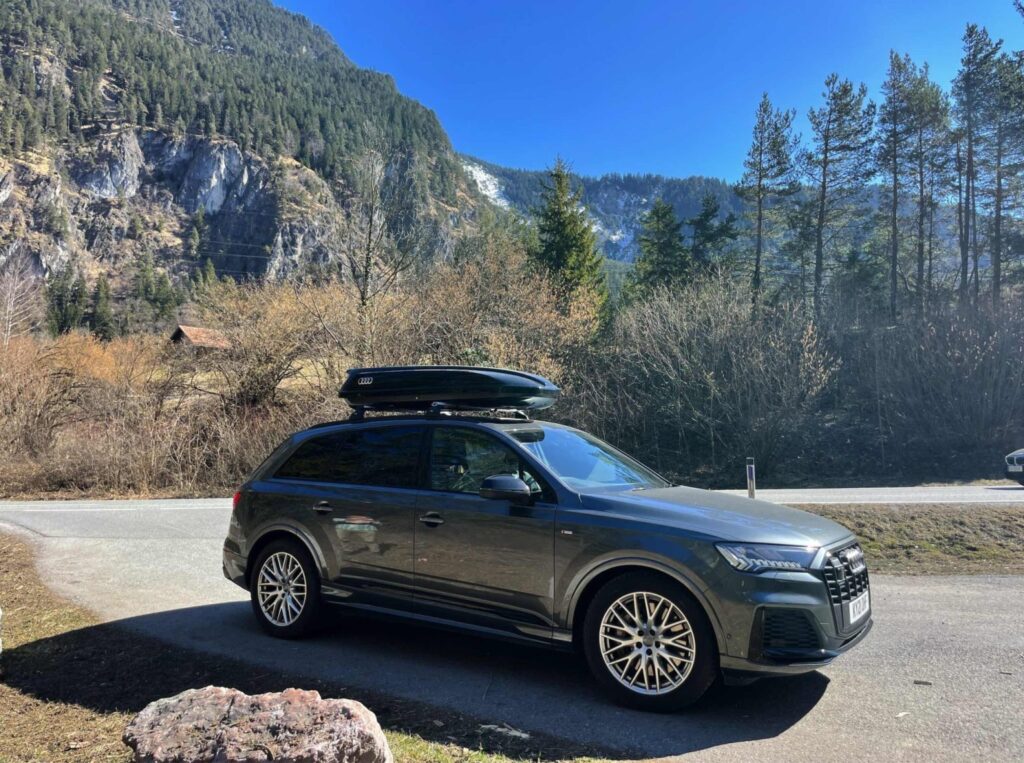
When the trip was a way off, it was easy to bat off the naysayers questioning the viability of going fully E in the mountains. Granted, this wasn’t a simple out-and-back ski trip, which, of course, many have done successfully and published their carefully planned charging routes to a chosen ski resort.
Even Audi (who was lending the car) was dubious… As we drew closer to kick off, one by one the team took a turn to have a wobble over whether doing a two-weeker in a full e-type was viable. Would we find enough charging stations? Perhaps we could be smart on the motorway slog down to the mountains, but what about in rural Austria? Were we setting ourselves up for getting stranded on the side of a mountain pass, all out of E…?
“I just want to skiiii,” cried one of us eventually in the WhatsApp group that had started out so positive. The game, after all, was not to sacrifice skiing in the name of better travel but to find the best way to make our old ski trip happen as-green-as-can-be.
We voted: 2-2. A compromise was drawn with a hybrid vehicle. But a range of 30km wasn’t going to get us through France, down the German autobahn and across the Austrian Alps. We agreed to keep it clean and switch to electric off the big roads, (with a rather lame excuse of preserving local air quality…). No, it wasn’t ideal, but let’s call it a soft launch for next year’s full electric ski trip; a recce of sorts, to check out Alpine EV infrastructure.
So, how did it go?
Altenmarkt – Faulty charger or user error – but the car plugged in overnight hadn’t charged, and we didn’t have any green gas to get us up the hill. We stumbled at the first hurdle of plan b and headed off to Zauchensee in a cloud of carbon.
Obertauern – We drive the car into the heated basement carpark of Cinderella hotel – a completely mad 4-star all-inclusive that’s brilliantly located and ski-in ski-out. The only issue is that the charger is tucked away under a bulkhead (!!). Off the roofbox comes…. Cinderella kindly takes on the task and charge it does, delivered back to us on checkout with roofbox on and skis packed. Success!
Leogang – is well set up for electric vehicles, best of any ski resort I’ve visited thanks to it being a hub of eco hotels.
Protect Our Winters (POW) states that transport accounts for 75% of global emissions within the tourism sector, of which 40% is attributable to air travel. Transport is therefore a key driver of climate change; raising temperature, shortening winters and reducing snowfall. As the outdoor community we see the impact of these changes through melting glaciers, increasing rockfall and smaller snowpacks.
It’s not unusual for resorts now to have invested and developed wind, solar and hydro power. But, in the grand scheme of things, this 25% (left from 75% transport contributed carbon) is negligible. What will move the needle is changing modal practices from planes and petrol cars to trains and EVs. An overhaul of the entire aviation system for sustainable fuel isn’t looking likely. Petrol cars will, one day, be banned. So if there’s snow to ski in the not-so-distant future, it’s to be about better trains and better electric infrastructure.
If the aim of the trip was to ski unrestrained by ‘charging fear’, keeping skiing the main agenda of the holiday (not scouting out charging ports), then our attempt at travelling by electric vehicle was a fail. Our hybrid needed a longer range than 30km and more rapid chargers are needed, well, everywhere. And of course it’s a situation of chicken and egg. If there’s more demand in resort for electric chargers – more chargers would be supplied. But who will drive to resort in an electric car until the charging situ on the ground is better? What’s the point of having an EV and travelling from North France to Austria, France, Switzerland, when you can’t get there to charge along the way, or without hold-up making the drive even longer…
The team is split. I, personally, thought that a fully electric car would have given a decent range, meaning that when we did source power, we could go longer, further without worrying. (I am someone that frequently runs out of petrol). Our more measured driver says he would not risk it (and fair enough he was the one sorting the car and driving round towns to plug in). Front seat passenger says she would no way do it electric until charging options match filling up with petrol. Back seat passenger says – “I just wanna skiiii”.
Should resorts be taxing carbon intensive assets to fund green investment? No fuel cars allowed, say? Someone will be the first resort to do it. But when?
CO2 Using two tanks of petrol each way, a quick calculation (though it changes with each carbon calculator) puts our output a little over 160kg for a return journey driving to Salzburg. Four flights come to 1.24 metric tons.
EUROTUNNEL Eurotunnel Le Shuttle produces on average 2kg of CO2 per car per crossing, compared to 147kg of CO2 for a typical Dover-Calais ferry. (That’s 73x less!). We paid £269 each way for Flexiplus tickets, meaning we could turn up any time and get on the next available train, with access to the club lounge. – see Eurotunnel Le Shuttle website